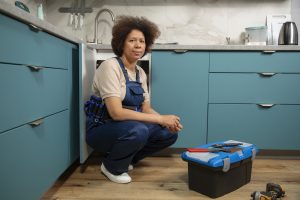Ever thought about saving money by doing home maintenance yourself? Diy home maintenance tasks are a great way to keep costs down. With the right tools and some guidance, you can handle many tasks without a pro. From cleaning gutters to fixing a leaky toilet, there’s a lot you can do yourself.
This article will show you a detailed maintenance checklist. It’s perfect for any homeowner looking to save time and money. Are you ready to take charge of your home’s upkeep? Let’s get started!
Inspect and Clean Your Gutters
Regularly checking and cleaning your gutters is vital for home upkeep. Safety is the first thing to remember. Always follow Safety First: Ladder Usage Tips when climbing. Make sure your ladder is steady and on a flat surface.
Start by getting the right tools like gloves, a trowel, and a bucket. These help you clear leaves and debris from the gutters. Gloves keep your hands safe from sharp things and dirt. After removing big debris, use a hose to get rid of smaller stuff. This makes sure water flows well through the downspouts.
While you’re up there, check the gutters for leaks and damage. Look for spots where water might leak out or where the gutter is coming loose. Fixing these problems early can stop bigger damage later and keep your gutters working right.
If using a ladder makes you nervous, think about other options. Gutter guards or a professional service can help. These choices mean you won’t have to do this often and you’ll feel more at ease. Remember, Safety First: Ladder Usage Tips is key for any DIY project.
Fixing a Running Toilet
Dealing with a running toilet is a key maintenance task for homeowners. It saves money on water bills and prevents water damage. Common causes include a faulty fill valve, wrong water level, and issues with the flush valve chain or flapper.
You can fix it yourself with basic tools. You’ll need channel locks, a screwdriver, a bucket, a towel, and a cloth or sponge. You might need to replace the fill valve, flush valve assembly, flapper, or float. Make sure the water level in the tank is about an inch below the overflow tube. Adjusting the float rod or float cup can solve many problems.
Toilet flappers should be replaced every three to five years. Fixing a running toilet is usually affordable. DIY fixes cost under $50. But, hiring a plumber can cost $75 to $400, depending on the issue.
For a detailed guide on adjusting and replacing these parts, check out this resource: how to fix a running toilet. By following these steps, you can do this important maintenance task yourself. This will prevent further problems and keep your home in good shape.
Changing HVAC Filters
Understanding why regular filter changes matter is key to better HVAC performance. Changing your HVAC filters often improves your home’s air quality. This leads to healthier living conditions.
Cleaner air filters also lower the strain on your HVAC system. This results in lower energy bills and longer equipment life.
To start, turn off your HVAC system for safety. Find the filter compartment near the air handler or furnace. The filter size is printed on the side of the current filter, making it easy to pick the right one.
High-efficiency filters are a good choice for better filtration.
Remove the old filter carefully and put in the new one. Make sure it fits well. It’s important to follow the arrows on the filter for the right airflow direction.
Once you’re done, close the compartment and turn your system back on.
Regularly changing HVAC filters is vital for air quality and system efficiency. It’s clear why this is important when you see the savings on energy bills and the longer life of your HVAC system. Make this simple habit part of your home care routine for year-round comfort.
Cleaning Dryer Vents
Cleaning your dryer’s vents is key to prevent fire hazards and keeping it running well. Lint builds up and can be a fire risk. Here’s how to keep your dryer vent clean:
- Disconnect your dryer from the power source.
- Remove the lint filter and clean out any visible debris.
- Use a vent brush to clean the lint trap and the accessible part of the duct.
- Detach the duct from the back of the dryer and use a vacuum or brush to remove lint buildup inside the vent.
- Reattach the duct, ensuring it’s securely connected.
- Plug your dryer back in and test it to ensure proper airflow.
Regular maintenance of dryer vents helps to prevent fire hazards, keeping your home safe. Signs of lint buildup include clothes taking longer to dry, a burning smell, and the dryer feeling hot. By fixing these issues quickly, you improve your dryer’s performance and home safety.
Basic Appliance Maintenance
Keeping your home appliances in good shape can really help prolong the life of these important tools. Having a maintenance schedule makes sure each appliance works well. This also lowers the chance of sudden failures, saving you money on repair costs.
Begin by checking your fridge’s coils often. Clean them with a brush or vacuum to stop overheating and save energy. Then, run your dishwasher empty with vinegar to clean it out and remove buildup.
For washing machines, clean the hoses regularly to avoid leaks and water damage. Also, clean the dryer lint trap after each use to prevent clogs and fires. Make sure to clean your oven after spills and check its seals often to keep it running right.
Having a good maintenance schedule for each appliance not only extends their life but also cuts down on unexpected repair costs. A bit of regular care can go a long way in keeping your appliances working well for a long time.
Caulking and Sealing Gaps
Keeping your home in top shape starts with caulking and sealing gaps. It’s a key DIY task that keeps your home warm and dry. The right caulk makes all the difference, depending on where you use it.
Before you start, make sure the surfaces are clean. Remove any old caulk, dirt, or debris. This step is key for a strong seal.
Applying caulk needs skill. Use a caulking gun and pick the right sealant. Spread the caulk smoothly, then smooth it out with a tool or your finger. This gives your work a professional look.
Here are some important tips:
- Do ensure the right conditions; caulk adheres best to dry, clean surfaces.
- Don’t apply caulk in extreme temperatures, as it may not cure properly.
- Do choose the right caulk for your specific needs—silicone for bathrooms, acrylic latex for exterior gaps, etc.
- Don’t over-apply; a small bead usually suffices.
By focusing on these tips and choosing the right caulk, you can protect your home from water damage. You’ll also make it more energy-efficient. With these steps, your DIY caulking will look great and last a long time.
Resetting a Tripped Breaker
Resetting a tripped breaker is a key skill for homeowners. Knowing how to find the Tripped Breaker quickly can save time and avoid more electrical problems.
Here’s how to reset a tripped breaker safely:
- First, open your electrical panel, usually in your garage or basement.
- Find the breaker that’s in the “off” position or not aligned with others. This is the tripped breaker.
- Make sure your hands are dry and there’s no moisture around the panel for safety.
- Switch the tripped breaker to the fully “off” position and wait a few seconds.
- Then, flip it back to the “on” position. You’ll hear a click when it resets successfully.
Breakers can trip for many reasons like an overloaded circuit, a short circuit, or a ground fault. Finding and fixing the cause can stop future trips.
Safety Tip: If a breaker keeps tripping, there might be a serious electrical problem. It’s important to call a licensed electrician to check your system. Keeping electrical safety in mind is essential for home maintenance.
DIY Home Maintenance Tasks
Starting do-it-yourself projects at home can be very rewarding. By fixing common problems yourself, you save money and learn new skills. As a handyman, you have the tools and skills to handle many home improvement tasks well.
Here are some key DIY home maintenance tasks every homeowner should try:
- Inspect and clean your gutters often to avoid water damage and roof problems.
- Fix a running toilet to save water and cut down on utility bills.
- Change HVAC filters now and then for better air and system efficiency.
- Clean dryer vents to stop fires and make drying faster.
- Do basic appliance upkeep to make them last longer and work better.
- Caulk and seal gaps to keep your home warm and save energy.
- Reset tripped breakers safely to get power back without a pro.
By doing these DIY home maintenance tasks, you’ll keep your home safe, efficient, and well-kept. You’ll feel proud of your work and add value to your home with each fix. Happy home repairing!
Cleaning and Replacing Faucet Aerators
Faucet aerators are key for saving water and keeping water flow steady. Knowing when to clean your aerator helps keep your faucets working well. Signs like lower water pressure or odd spray patterns mean it’s time to clean.
Here’s a list of tools and supplies you will need:
- Adjustable wrench
- Pipe tape
- Toothbrush
- Bowl
- White vinegar
Here’s how to take apart, clean, and put back your faucet aerator:
- Wrap the wrench with pipe tape to protect your faucet. Then, unscrew the aerator by turning it clockwise.
- Take apart the aerator and soak its parts in white vinegar for 30 minutes. This helps break down mineral buildup.
- Scrub with a toothbrush to get rid of any leftover debris. Make sure to clean out all small clogs.
- Rinse everything with water and put the aerator back together. Screw it onto the faucet by turning it counterclockwise.
Cleaning your faucet aerators regularly is part of good monthly home maintenance. It stops clogs and makes your plumbing last longer. If cleaning is hard or you’re unsure, getting help from a professional plumber is a good idea.
Maintaining Your Water Heater
Keeping your water heater in top shape is key to its long life and efficiency. Simple steps can help your water heater work better and save you money.
Start by draining your water heater once a year. This removes sediment that can slow it down. First, turn off the power and water supply. Then, attach a hose to the drain valve and aim it to a safe spot. Open the valve and let the water drain until it’s clear.
Also, check the anode rod while draining. It fights rust inside the tank. If it’s corroded, replace it to make your water heater last longer.
Don’t forget to check the temperature settings. Keeping it around 120°F is safe and efficient. If you see leaks or odd behavior, call a licensed plumber for a check-up.
By following these steps, you can keep your water heater running smoothly. Remember, taking care of your water heater is an investment in your home’s comfort and your peace of mind.
Removing Stains from Driveways
Keeping your driveway clean is key to your home’s look. It’s important for home upkeep and makes your property look better.
Driveways can get stains like oil leaks, rust, and mildew. Each stain needs a special way to get rid of it:
- Oil Stains: Absorb spills with kitty litter or sawdust. Then, scrub with a detergent that cuts grease. For hard stains, try degreaser or baking soda and water.
- Rust Stains: Rust comes from tools or furniture. Use lemon juice and water or a rust remover to remove stains.
- Mildew and Algae: Mix bleach and water to kill mildew and algae. Regular washing also stops them from coming back.
Cleaning your driveway often keeps it looking good. Also, sealing it after cleaning stops stains from coming back. These steps keep your driveway clean and your home looking great.
Conclusion
Learning these home maintenance tasks can make your home last longer and safer. It doesn’t matter if you’re new to owning a home or have been for years. Staying on top of these tasks can save you money and keep your home nice to live in.
Checking and cleaning your gutters stops water damage. Fixing a leaky toilet and changing HVAC filters keeps your systems working well. Cleaning your dryer vents lowers fire risks, and looking after your appliances makes them last longer.
Sealing gaps and caulking stops drafts and pests. Knowing how to fix a tripped breaker saves you money and time. Cleaning and swapping out faucet aerators also boosts water flow and saves water.
Keeping your water heater in good shape and cleaning your driveway keeps your home looking great. By doing these essential home tasks, you’ll keep your home in top condition. These steps are key for anyone, whether you’re new to homeownership or have been for a while. Every little bit helps make your home a safer, happier place for you and your family.
FAQ
How often should I inspect and clean my gutters?
Clean your gutters at least twice a year, in spring and fall. This stops clogs and water damage. It also makes your gutters last longer.
What safety precautions should I take when cleaning gutters?
Use a strong ladder on a firm base. Wear waterproof gloves and have someone watch you. Don’t use the ladder in bad weather.
How do I check for leaks and structural damage in my gutters?
Look for cracks, rust, or where water doesn’t drain right while cleaning. Water stains on walls might mean leaks.
How do I change HVAC filters?
Turn off your HVAC first. Find your filter, take out the old one, and put in a new one. This keeps the air clean and your system working well.
Why is it important to clean dryer vents regularly?
Cleaning dryer vents stops lint build-up, a fire risk. It also makes your dryer work better, saving energy and money.
What type of caulk should I use for sealing gaps in my home?
Choose caulk based on where and what it’s for. Acrylic latex is good for inside. Silicone or urethane works better outside because they last longer and handle weather.
How do I reset a tripped circuit breaker?
Find your breaker panel and the tripped breaker. Reset it by flipping it to “off” and then “on.” Always be careful with electrical safety.
How can I identify when a faucet aerator needs cleaning?
If water flow is weak or uneven, clean your aerator. Just unscrew it, soak parts in vinegar, and put it back.
What is the best way to remove stains from driveways?
Use a degreaser for oil stains or a soap and hot water mix. For rust, try a rust remover or vinegar and baking soda. Always rinse well to avoid residue.
How often should I perform maintenance on my water heater?
Check your water heater once a year. Look for leaks, flush the tank, and set the temperature right (usually 120 degrees Fahrenheit).





